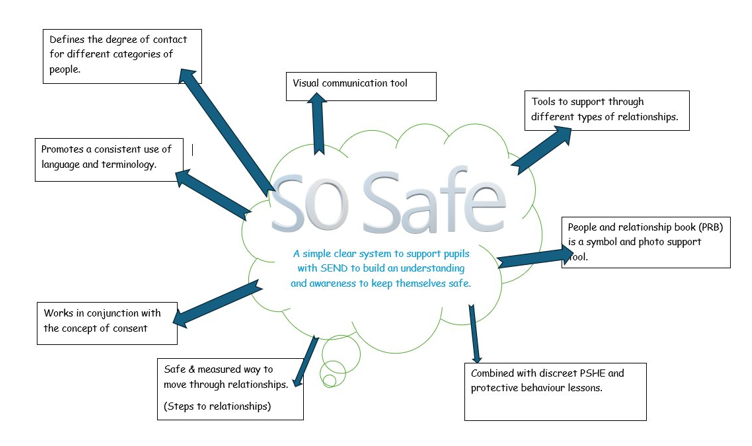SoSafe! for healthy relationships
What is So safe?
SoSAFE! is a system designed to help children with special educational needs learn:
- about keeping themselves safe,
- how to accept support in different types of relationships,
- what makes a positive healthy relationship.
It uses a standardised framework of symbols, visual teaching tools and concepts aswell provides visual communication tools for reporting physical or sexual abuse so that young people can advocate for themselves. It is important to stress that SoSafe! is not a sex education tool.
SoSafe! provides a set of conceptual tools designed to promote social safety through:
- the provision of a simplified and ‘rule-governed’ model of social reality,
- teaching the type and degree of verbal and physical touch appropriate with different categories of people,
- when appropriate, teaching strategies for moving into intimate relationships in a safe and measured manner,
- providing visual communication tools for reporting physical or sexual abuse,
- facilitating and maintaining support networks.
At Billing Brook, we know that all of our children are vulnerable, in particular how they communicate and how they understand interaction with others and relationships. Through our teaching, including using SoSafe! tools, we endeavour to build their understanding and awareness of how to keep themselves safe at all times. This relates to all pupils’ learning within our curriculum especially in aspects of My Health (especially PSHE and RSE) and My Living Skills.
Some of the key concepts in the initial stages of the SoSafe! strategy are:
- Some body parts are private and we cover them with underwear/swimwear,
- consent must be given,
- children have a right NOT to consent to others’ help (with staff following a duty of care).
These concepts relate to a variety of contexts including when needing support with hygiene, medical assistance and toileting.
We introduce CONSENT very early on in order for children to safeguard themselves from unwanted touch and potential abuse. We ensure that children can use a range of ways to communicate yes/give consent (Speaking, visual prompts, gestures etc ) and practice this in through different scenarios.

How is SoSafe! taught?
Specific aspects are taught during PSHE lessons and key concepts and vocabulary are reinforced at opportune moments throughout the day e.g. going to the toilet, changing for PE/swimming. This builds a solid understanding of the core SoSafe! language, so that it becomes embedded.
Some of the Key Vocabulary:
Private parts, public parts, mouth, bottom, penis, vagina, breasts, consent, helpers, pants, vests, underwear/swimwear, private places, public places, private things/actions, underwear, tampons, sanitary towels, bathroom, toilet, changing room, bedroom, male, female.
N.B. it is important that factual language is used for body parts to ensure absolute clarity about what these parts are called, and the concepts of public and private and consent. Euphemisms for body parts can be confusing and not known by everyone, so a child saying ‘my button was touched and I don’t like it’ may be misunderstood, but factual names will not.
Further support for parents/carers:
We recognise these are difficult concepts to teach and it can be daunting, even embarrassing, to approach these subjects. Using principles from the SoSafe! program helps to give clarity in the messages for young people with SEND and for teaching staff and parents/carers to deliver them.
You can find more information about SoSafe! on their website: https://sosafeprogram.com/
Pyramid Educational Consultants, who deliver SoSafe! training in the UK also often facilitate free overviews on SoSafe! to give information about what it is and how it is taught, click the link below to sign up:
SoSAFE! Overview Free 1 Hour Talk (pecs-unitedkingdom.com)
If you have any concerns or questions about SoSafe! please contact the school office on the general enquiries email address generalenquiries@bbrook.co.uk




